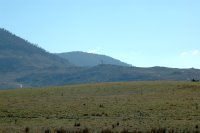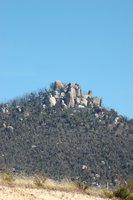 The edges of Canberra and much of the Snowy Mountains (in both Victoria and New South Wales) were subjected to a huge and devastating Wild Fire in January 2003. For Canberra it was a specific day, January 18th, but the fire had been burning for several weeks in a contained area west of Canberra before then. Then, another branch of the fire spread south, through the Tidbinbilla Nature Reserve, and burnt up into the Snowy Mountains. At the same time, equally devastating fires were burning similar country in the Victorian Alps.
The edges of Canberra and much of the Snowy Mountains (in both Victoria and New South Wales) were subjected to a huge and devastating Wild Fire in January 2003. For Canberra it was a specific day, January 18th, but the fire had been burning for several weeks in a contained area west of Canberra before then. Then, another branch of the fire spread south, through the Tidbinbilla Nature Reserve, and burnt up into the Snowy Mountains. At the same time, equally devastating fires were burning similar country in the Victorian Alps.
The foothills of the mountains were planted with Pinus radiata, which were totally destroyed, and hopefully will not be allowed to regrow.
There is a mythology in Australia, that it always rains after a big bushfire. I am here to tell you that it is not true.
After a fire, native trees recover according to their own methods of survival, which have developed according to patterns of evolution, over geological periods of time. Generally Eucalypts experience a total burrning of their oil-filled leaves, during a fire, but new growth occurs from dormant buds under the thick, protective bark of the tree. Generally! The tallest of the wet mountain Eucalypts, the "Mountain Ash", have lost this genetic survival strategy. They tend to die in fires. That is possibly because when a fire takes hold in their territory, of tall timber, and dense forest, the intensity of the fire is such that even the sap-wood of these huge trees is dried out and killed. Anyway, Mountain Ash generally rely on seedling regrowth after the fires.
The news is better for most other Eucalypt trees. They experience a sudden burst of new growth, and the forest quickly greens up again. Normally! This is where the presence of rain is important after a fire. Since the 2003 fires, the entire alpine region has continued in drought, so the burst of regrowth which followed the fires, dried out, and many trees died entirely. Those trees which did survive, have struggled on, severely damaged. And they are still waiting for rain.
 The Baroomba Rocks at Tidbinbilla are a small cluster of huge granite boulders, each several times the size of a normal house. Big rocks, or a small mountain, you decide.
The Baroomba Rocks at Tidbinbilla are a small cluster of huge granite boulders, each several times the size of a normal house. Big rocks, or a small mountain, you decide.
The thing is how bare they are now. These rocks are clearly visible from Canberra, some 40 Km away. The main reason is how bald they now are. There were forest trees all around them, and the rocks were moss-covered. Now the trees are barely alive, and the rock faces are bare. So, from Canberra, these rocks stand out as a pyramid shaped mountain, in front of the much larger Tidbinbilla Range in the background.
These rocks bear tribute to the need for rain in South-east Australia.
Today 62 % of NSW is declared in drought condition. And this very week, the Federal Government, (and I am ashamed to say - the NSW Government is supporting this idea) is proposing to sell the Snowy Mountains Hydro-Electric Scheme to private interests. God help this country run by Free Market Idealogues. One day we will remember that there is such a thing as an over-riding National Interest.

2 comments:
Denis, I always learn something new on your blog. I didn't know the difference with Mountain Ash. Down here in the Dandenongs that's what we have lots of. Come and see. I agree with you about the Snowy River scheme. Hands up those who agree with the sale? It's the same with water - just as this basic necessity of humanity becomes a major issue we are putting it in the hands of private enterprise and developing a "market". And this is going to protect our source of life!? Never stand in the way of a dollar seems to be the only principle guiding politicians to-day - whatever their colour. And I've something to say on modern trends in financing major projects and infrastructure to-day......but I'll save that for when I get back to blogging next week.
Blessings, bliss and Berger
Hi Miss Eagle
Thanks for the comment on the Mountain Ash trees. One of my earliest memories as a child from Melbourne was going out to the Dandenongs (probably Ferntree Gully area) and seeing the scarred hillsides from the great 1939 Bushfires. Seeing as I was born in 1948, this would be a memory from the mid 1950s - 12 to 15 years after those fires. I vividly recall seeing huge tree trunks on the mountain horizons, still standing out above the new tree growth below. And of course those new trees were already quite large. These trees were skeltons, still standing above the new trees.
Cheers Denis
Post a Comment